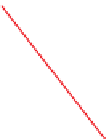Graphics Reference
In-Depth Information
Table 32.1: Symbols used in the path tracer.
Symbol
Meaning
E
The eyepoint.
P
A surface point in the scene, often the first one encountered
by a ray from the eye, but sometimes used generically.
Q
,
Q
j
A point on the surface of a luminaire or some other source of
light arriving at
P
, such as an illuminated reflective surface.
The unit normal vector at
P
, which we've denoted
n
(
P
)
pre-
viously, or the same thing for
Q
.
n
P
,
n
Q
A unit vector pointing from
P
toward some source of light.
v
i
A unit vector pointing from
P
in the direction in which
reflected light from
v
o
v
i
exits, typically toward
E
.
A generic name for a unit vector, typically based at
P
.
v
L
(
P
,
)
The radiance at a surface point
P
in direction
. Note that in
v
v
this chapter we only define
L
for surface points.
L
e
(
P
,
)
The light emitted at point
P
in direction
; zero except when
v
v
P
is a point of a luminaire.
L
j
(
P
,
v
)
The light emitted by the
j
th luminaire.
L
r
(
P
,
)
v
The light reflected or transmitted (refracted) at
P
in direction
v
.
L
=
L
e
+
L
r
.
L
ref
(
P
,
)
The light reflected at
P
in direction
.
v
v
L
trans
(
P
,
.
L
r
=
L
ref
+
L
trans
.
)
The light transmitted at
P
in direction
v
v
f
s
The bidirectional scattering distribution function.
f
s
The “impulse” part of
f
s
, corresponding to transmission or
mirror reflection.
f
s
The finite part of
f
s
, corresponding to nonmirror reflection.
Let's suppose that there are
k
luminaires in the scene, each producing an emit-
ted radiance field
(
Q
,
L
j
(
Q
,
)
→
)
,
(
j
=
1,
...
,
k
)
which for any point-vector
v
v
pair
(
Q
,
)
with
Q
on a surface and
v
·
n
Q
>
0 is zero, except for points on the
v
j
th luminaire, and directions
in which the light emits radiance. Most often this
radiance field will be Lambertian, that is,
L
j
(
Q
,
v
v
E
)
will be a constant for
Q
on the
v
t
luminaire and any
with
v
·
n
Q
>
0; it's zero otherwise. But for now, we'll just
v
assume that it's a general light field.
Furthermore, let's assume that all surfaces are opaque—the only scattering
that takes place is reflection. The change to include transmission will be relatively
minor.
P
=
E
-
t
v
The rendering equation tells us that if
P
is the first point at which the ray
→
−
t
E
t
v
hits the geometry in the scene (see Figure 32.7), then
Figure 32.7: The eye E looks into
the scene and sees P at distance t.
L
(
E
,
)=
L
(
P
,
)
(32.5)
v
v
+
v
i
∈
S
+
(
n
P
)
=
L
e
(
P
,
)
emitted
f
s
(
P
,
)
L
(
P
,
−
v
i
)
v
i
·
v
v
i
,
v
n
P
d
v
i
.
(32.6)
scattered

























